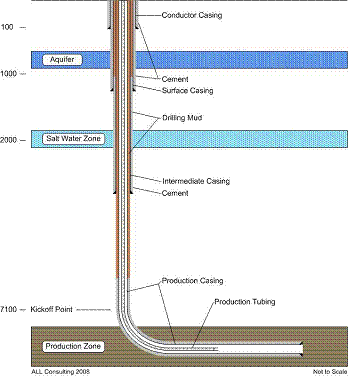BENEFITS: Big Shoes, Small Footprint
Beyond shale’s contribution to greenhouse gas (GHG) reduction, the production of shale also has an impact on land use.
 |
|
Source: DOE |
The process of setting up the rig, drilling, fracturing, stimulating, and installing operational equipment for a single shale well takes approximately two to eight weeks.
First, developers begin construction of a drill site for one well or pad site if there are multiple wells. Once the drilling rig and other necessary equipment are in place, the drilling process begins. Steel casings are then inserted into the well at depths ranging between 1,000 and 3,000 feet. Once the casings are in place, the space between the casing and the drilling hole is filled with cement to stabilize the well and prevent any leakage. Once the cement sets, smaller casings are lowered to a depth of 10,000 feet and secured by cement. These multiple layers of steel casing and cement serve to provide a strong foundation, stability and integrity, as well as prevent contamination or fluid loss.
As a well reaches the completion phase, the original drilling rig is removed and a smaller completion rig is moved in to perforate and treat the potentially productive zones through hydraulic fracturing. Drill sites are designed to utilize as small an area as possible that can still safely accommodate a drilling rig and associated equipment. Once drilling is completed, the drill site is further reduced to a minimum area for the surface production equipment.
Finally, a wellhead or “Christmas tree” is placed on top of the existing well site to control and regulate the flow of gas into a pipeline in order for the gas to be transported to market through a regional pipeline system. A typical natural gas Christmas tree structure is about the same height as a 6-foot tall man.
At the conclusion of this process, well developers begin the land reclamation process, and seek to leave behind a small footprint for each well pad site. The land restoration process involves landscaping and contouring the property as close as possible to pre-drilling conditions, according to Marcellus Shale Coalition.
 |
|
Source: DOE, Department of Fossil Energy |
After the initial two to eight weeks of construction and fracturing, natural gas production from shale requires considerably less land than other energy sources. For example, both solar power and wind power require approximately six acres each to produce the electricity necessary to serve 1,000 households for one year. Natural gas production requires the least amount of surfaceland among all the current energy sources, requiring only .03 acres to serve 1,000 households for one year.